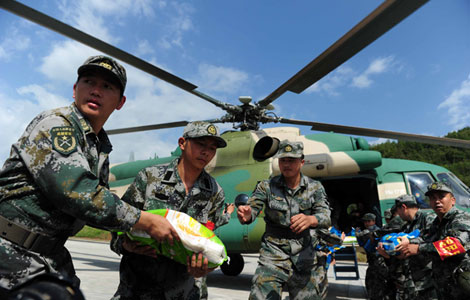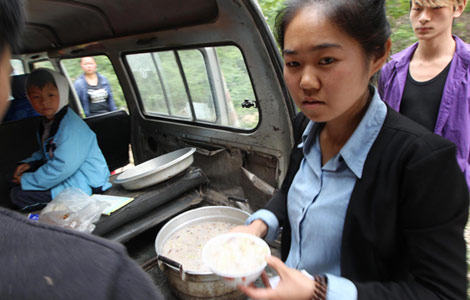Onset of flood season adds to quake zone risks
Updated: 2013-04-26 01:51
By HE DAN in Beijing and AN BAIJIE in Lushan, Sichuan (China Daily)
|
||||||||
Monitoring and prevention efforts will be stepped up as secondary geological events overlapping with the flood season present a tremendous challenge for disaster relief operations in Sichuan province's quake-hit areas, said a senior official of the provincial government on Thursday.
Probe teams have discovered more than 1,900 high-risk spots in Lushan and Baoxing counties, Zhong Mian, executive deputy governor of Sichuan province, said at a news conference in Beijing.
The two counties in Ya'an were the areas most affected by the magnitude-7 earthquake on April 20.
"Ya'an is a place with abundant rainfall and heavy rain is very common during the flood season. Strong rain in the earthquake zone will easily trigger devastating geological disasters," Zhong said.
He said the weather has caused landslides along the major route for transporting disaster relief materials, which has made relief work difficult.
Aware of the challenges, the government has dispatched 17 teams to carry out thorough geological examinations and send out emergency alerts.
The local government will also carefully evaluate the potential risks of geological disasters and flooding in resettlement spots, he said, adding that the government will remove people from dangerous places.
The measures came after President Xi Jinping called on Sichuan authorities and all departments involved in disaster relief work to take effort to prevent secondary disasters, further casualties and economic losses, China Central Television reported on Thursday night.
Song Xingren, a resident of Xinmin, a village in Baoxing county, said a rescue team, who risked their lives to transport the food along a severely damaged 40-km mountainous road, distributed instant noodles to about 100 households in the village on Wednesday.
"But we still lack food, drinking water and shelter," said the 57-year-old, adding that the quake destroyed all of the houses in the village and its two wells.
"My family has stored some food, but we cannot get to it because our house was smashed by a huge rock, so I have to borrow grain from relatives," Song said.
Pang Chenmin, deputy director of the Ministry of Civil Affairs' department of disaster relief, told media that the shortage of daily necessities in the hard-hit areas has been eased since roads cleared on Tuesday could be used to transport relief supplies on Wednesday.
He said major temporary resettlement spots and major roads had portable toilets as of Thursday.
Zhong from the Sichuan provincial government said safe drinking water will soon be restored for the 2 million people in the province once the repair work on water plants, pipes and reservoirs is completed.
He said the surface water has not been polluted by the quake, based on the findings of environmentalists and irrigation experts.
Qiu Jian, chief planner with the Sichuan Department of Housing and Urban-Rural Development, said quake-resistant buildings constructed after the 2008 Wenchuan earthquake have passed the test of the recent quake in Ya'an.
Those buildings were designed and built to resist a magnitude-8 earthquake.
Although some new buildings suffered varying degrees of damage during the quake in Ya'an, none of their main structures collapsed, Qiu said.
"Buildings that were part of the reconstruction program, especially public buildings where large numbers of people would be, such as schools and hospitals, have protected people's lives," he said.
China decided not to invite international disaster relief forces after the quake given the relatively small area of the earthquake zone, Zhao Ming, director of the China Earthquake Administration's department of emergency response and disaster relief, told China Daily.
After the quake, the government dispatched about 16,000 soldiers and police officers to the area, he said.
Most Viewed
Editor's Picks

|

|

|

|

|

|
Today's Top News
Phone bookings for taxis in Beijing
Chinese consumers push US exports higher
Seoul delivers ultimatum to DPRK
Boston bombing suspects intended to attack NYC
No let up in home price rises
Bird-watchers undaunted by H7N9 virus
Onset of flood season adds to quake zone risks
Vice-president Li meets US diplomat
US Weekly

|

|















